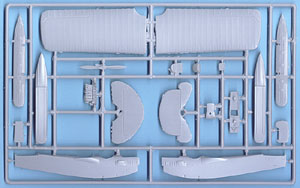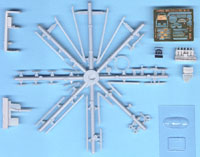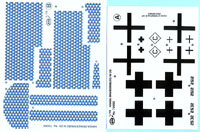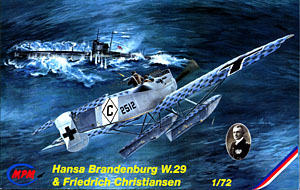MPM's 1/72 Hansa Brandenburg W.29 | | History The German's made extensive use of seaplanes in the First World War, one of the best was the W.29. Supposedly designed by Ernest Heinkel on a napkin by making changes to the earlier biplane W.12. Whatever the truth to this, the result was undoubtedly one of the best two-seat naval aircraft of the war. The W.29 entered service in early summer 1918, and postwar it was used by many nations in both its original, and licence-built form by Latvia, Denmark, Norway, Finland and Japan. The Kit  MPM's W.29 has been out since 1997, but this recent release is one of their "Upgrade" kits with extra resin parts. Like most of the other early MPM kits that are being upgraded, this kit has a combination of etched brass details and somewhat rough injection molded plastic parts. There is some heavy flash around the edges that will need to be cleaned up, but once that's done the assembly should be very straightforward. MPM's W.29 has been out since 1997, but this recent release is one of their "Upgrade" kits with extra resin parts. Like most of the other early MPM kits that are being upgraded, this kit has a combination of etched brass details and somewhat rough injection molded plastic parts. There is some heavy flash around the edges that will need to be cleaned up, but once that's done the assembly should be very straightforward.
The resin details get you started right away with a complete cockpit assembly, replacing nearly every kit part except for the pilot's wheel and the seatbelts. Between the resin and brass details the cockpit section will really look sharp. Continuing the line of resin interior parts, the other main resin part is the engine, and it's a very nice rendition that will look outstanding once painted up. The only thing I'd replace would be the exhaust stubs with steel tubing.  The rest of the kit is very basic and should be a quick build. There is minimal rigging on this kit, and the only real challenge will be in getting all the float struts aligned correctly. There is a nice head-on drawing showing alignment, though, so this step shouldn't be too tough. The wings are solid right and left sections, and you have two different one-piece stabilizers to build different variants. The breakdown of the parts will mean that there will be minimal filler needed, and the only structural addition I'd make would be to pin the wings. In fact, you could probably bend a piece of steel rod to the proper dihedral get a much stronger wing-fuselage joint. The rest of the kit is very basic and should be a quick build. There is minimal rigging on this kit, and the only real challenge will be in getting all the float struts aligned correctly. There is a nice head-on drawing showing alignment, though, so this step shouldn't be too tough. The wings are solid right and left sections, and you have two different one-piece stabilizers to build different variants. The breakdown of the parts will mean that there will be minimal filler needed, and the only structural addition I'd make would be to pin the wings. In fact, you could probably bend a piece of steel rod to the proper dihedral get a much stronger wing-fuselage joint.
 There are two decal options, one of which is the mount of Oblt. z. S. Friedrich Christiansen, the German aviatior that was credited with the first W.29 kills (two F2A Felixstowes on July 4, 1918). Both planes are finished in the same scheme, with naval lozenge on the upper surfaces, light gray blue sides, and CDL undersides of the wings & tailplanes. Christiansen's W.29 carries a white band on the rear fuselage with a black diamond outline with a letter C inside. The crosses are all oversized on this one as well. The second option has thin crosses and just a fuselage number of 2532 on the sides. The decals were printed by Propagteam in 1997 (original release) and feel a bit different than their current decals, but I'm sure their quality is the same. Both the individual markings and all the upper surface naval lozenge are included. There are two decal options, one of which is the mount of Oblt. z. S. Friedrich Christiansen, the German aviatior that was credited with the first W.29 kills (two F2A Felixstowes on July 4, 1918). Both planes are finished in the same scheme, with naval lozenge on the upper surfaces, light gray blue sides, and CDL undersides of the wings & tailplanes. Christiansen's W.29 carries a white band on the rear fuselage with a black diamond outline with a letter C inside. The crosses are all oversized on this one as well. The second option has thin crosses and just a fuselage number of 2532 on the sides. The decals were printed by Propagteam in 1997 (original release) and feel a bit different than their current decals, but I'm sure their quality is the same. Both the individual markings and all the upper surface naval lozenge are included.
Conclusion The MPM kit of the Hansa Brandenburg W.29 was welcome amongst WWI modelers when it first came out, and now that they've upgraded it by adding resin details, it will be even more welcome. My only wish is that MPM would market the extra resin details separately for all of us who have a couple original kits sitting in the closet. | 









    |

 MPM's W.29 has been out since 1997, but this recent release is one of their "Upgrade" kits with extra resin parts. Like most of the other early MPM kits that are being upgraded, this kit has a combination of etched brass details and somewhat rough injection molded plastic parts. There is some heavy flash around the edges that will need to be cleaned up, but once that's done the assembly should be very straightforward.
MPM's W.29 has been out since 1997, but this recent release is one of their "Upgrade" kits with extra resin parts. Like most of the other early MPM kits that are being upgraded, this kit has a combination of etched brass details and somewhat rough injection molded plastic parts. There is some heavy flash around the edges that will need to be cleaned up, but once that's done the assembly should be very straightforward. The rest of the kit is very basic and should be a quick build. There is minimal rigging on this kit, and the only real challenge will be in getting all the float struts aligned correctly. There is a nice head-on drawing showing alignment, though, so this step shouldn't be too tough. The wings are solid right and left sections, and you have two different one-piece stabilizers to build different variants. The breakdown of the parts will mean that there will be minimal filler needed, and the only structural addition I'd make would be to pin the wings. In fact, you could probably bend a piece of steel rod to the proper dihedral get a much stronger wing-fuselage joint.
The rest of the kit is very basic and should be a quick build. There is minimal rigging on this kit, and the only real challenge will be in getting all the float struts aligned correctly. There is a nice head-on drawing showing alignment, though, so this step shouldn't be too tough. The wings are solid right and left sections, and you have two different one-piece stabilizers to build different variants. The breakdown of the parts will mean that there will be minimal filler needed, and the only structural addition I'd make would be to pin the wings. In fact, you could probably bend a piece of steel rod to the proper dihedral get a much stronger wing-fuselage joint. There are two decal options, one of which is the mount of Oblt. z. S. Friedrich Christiansen, the German aviatior that was credited with the first W.29 kills (two F2A Felixstowes on July 4, 1918). Both planes are finished in the same scheme, with naval lozenge on the upper surfaces, light gray blue sides, and CDL undersides of the wings & tailplanes. Christiansen's W.29 carries a white band on the rear fuselage with a black diamond outline with a letter C inside. The crosses are all oversized on this one as well. The second option has thin crosses and just a fuselage number of 2532 on the sides. The decals were printed by Propagteam in 1997 (original release) and feel a bit different than their current decals, but I'm sure their quality is the same. Both the individual markings and all the upper surface naval lozenge are included.
There are two decal options, one of which is the mount of Oblt. z. S. Friedrich Christiansen, the German aviatior that was credited with the first W.29 kills (two F2A Felixstowes on July 4, 1918). Both planes are finished in the same scheme, with naval lozenge on the upper surfaces, light gray blue sides, and CDL undersides of the wings & tailplanes. Christiansen's W.29 carries a white band on the rear fuselage with a black diamond outline with a letter C inside. The crosses are all oversized on this one as well. The second option has thin crosses and just a fuselage number of 2532 on the sides. The decals were printed by Propagteam in 1997 (original release) and feel a bit different than their current decals, but I'm sure their quality is the same. Both the individual markings and all the upper surface naval lozenge are included.







